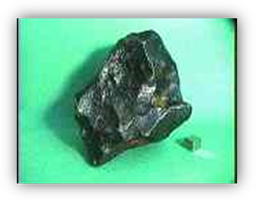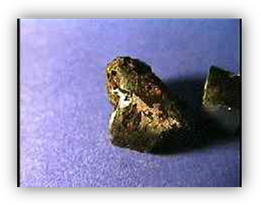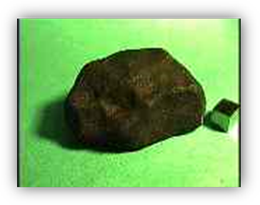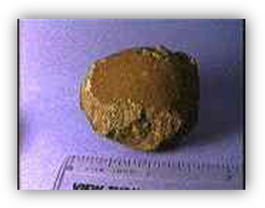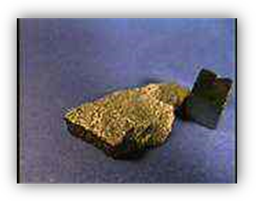ASTEROIDS AND COMETS
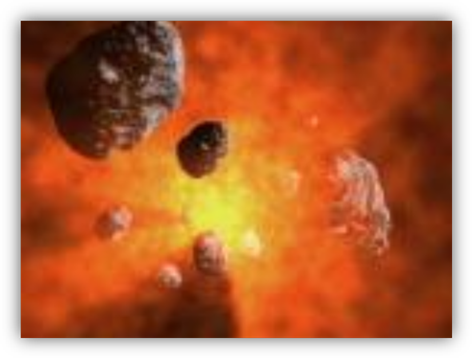
Unit Overview
This unit will investigate
the composition and orbits of asteroids and comets. A study of the effects that
asteroids and comets have on other planetary bodies will also be included.
Unit Directions
Read the unit below, complete
all activities, and complete the test at the end of the unit. It is helpful to
review the key terms before you begin the unit.
|
GLOSSARY OF KEY
TERMS |
|
asteroid - a
medium-sized rocky object orbiting the Sun; smaller than a planet, larger
than a meteoroid |
|
Asteroid
belt
- Region of the solar system, between the orbits of Mars and Jupiter, in
which most asteroids are found. It is the dividing line between the inner
planets and the outer planets in our solar system |
|
Ceres - the largest
asteroid in our solar system |
|
coma - A diffuse,
luminous cloud of dust and gas that develops around a comet's nucleus as it
nears the sun. |
|
comet - a relatively
small extraterrestrial body consisting of a frozen mass that travels around
the sun in a highly elliptical orbit |
|
comet
nucleus
- Solid part of the comet containing ices and dust that is close to the Sun,
the source of a coma, dust and plasma tails. |
|
dust
tail
- one of the two tails of a comet made of dust grains that curves away from
the Sun from the action of the photons in the sunlight pushing the dust
grains away from Sun. It has a yellow-white color from reflected sunlight. |
|
ejecta - Material such
as glass (melted silicon) and fragmented rock thrown out of an impact crater
during its formation. |
|
impact
crater
- Impact craters are the remains of collisions between an asteroid, comet, or
meteorite and the Earth. |
|
ion
tail
- one of the two tails of a comet made of ionized particles that points
directly away from the Sun from the action of the solar wind. It has a bluish
color from the emission lines mostly of ionized carbon monoxide. |
|
Kuiper
Belt
- A large ring of icy, primitive objects beyond the orbit of |
|
meteor - a streak of
light in the sky at night that results when a meteoroid hits the earth's
atmosphere and air friction causes the meteoroid to melt or vaporize or
explode |
|
meteorite - Matter that
has fallen to the earth's surface from outer space |
|
Oort Cloud - a large
spherical cloud of billions to trillions of comets surrounding the Sun at
distances between roughly 50,000 to 100,000 AU from the Sun. It has not been
directly observed; its presence is inferred from the behavior and orbits of
the long period comets. |
|
orbit - the (usually
elliptical) path described by one celestial body in its revolution about
another |
|
shooting
star
– a term used for meteor |
Print out the Key
Term worksheet for extra practice. Key Term Worksheet
Space Junk?
There is a great deal of
matter that is flying around in outer space! You already know about planets,
the sun and stars, and the forces that affect them. This unit will look at some
of the smaller pieces of matter that seem to be no more than space junk and
that term may be more accurate than you think.
Asteroids
Asteroids
are formed from left over material remaining after the formation of our solar
system. They are composed of rock and metals that did not form into the main
planets. They orbit our sun just as the planets do. Many of the asteroids are quite large and even have
been given names by scientists! Ceres is the largest asteroid in our solar system and is around 1000 km in diameter.
There are also many asteroids that
are the size of pebbles. All the
asteroids in our solar system have orbits and the majority of them are
located in the asteroid belt. This belt is located between Mars and Jupiter.
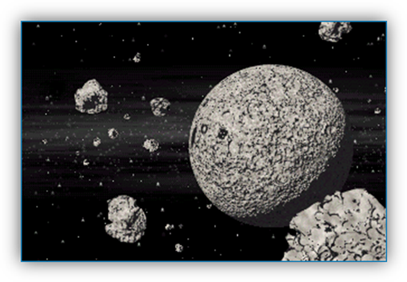
As you can see in the picture
above, asteroids not only come in different sizes, but many different shapes.
Ceres is the very spherical, large asteroid that looks like a small planet.
Scientists sometimes refer to the asteroids as the minor planets.
Below is a chart showing some
physical data and history of discovery of several asteroids.
|
ASTEROID SUMMARY |
||||||
|
Num |
Name |
Radius |
Distance* |
Discoverer |
Date |
|
|
1 |
Ceres |
466 |
413.9 |
0.10 |
G. Piazzi |
1801 |
|
511 |
Davida |
168 |
475.4 |
0.05 |
R. Dugan |
1903 |
|
433 |
Eros |
17.5 x 6.5 |
218 |
? |
G. Witt, A. Charlois |
1893 |
|
15 |
Eunomia |
136 |
395.5 |
0.19 |
De Gasparis |
1851 |
|
52 |
Europa |
156 |
463.3 |
0.06 |
Goldschmidt |
1858 |
|
951 |
Gaspra |
17x10 |
330.0 |
0.20 |
Neujmin |
1916 |
|
10 |
Hygiea |
215 |
470.3 |
0.08 |
De Gasparis |
1849 |
|
243 |
Ida |
58x23 |
428 |
? |
J. Palisa |
29 Sep 1884 |
|
704 |
Interamnia |
167 |
458.1 |
0.06 |
V. Cerulli |
1910 |
|
253 |
Mathilde |
28.5 x 25 |
396 |
0.03 |
J. Palisa |
1885 |
|
2 |
Pallas |
261 |
414.5 |
0.14 |
H. Olbers |
1802 |
|
16 |
Psyche |
132 |
437.1 |
0.10 |
De Gasparis |
1852 |
|
87 |
Sylvia |
136 |
521.5 |
0.04 |
N. Pogson |
1866 |
|
4 |
262.5 |
353.4 |
0.38 |
H. Olbers |
1807 |
|
|
*Mean distance from the Sun. |
||||||
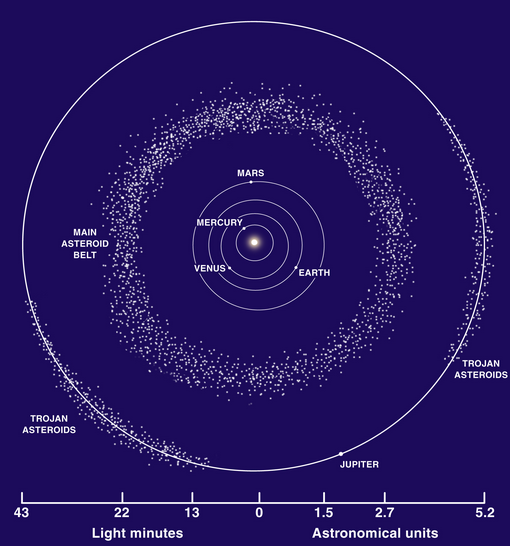
The Asteroid Belt
The asteroid belt is the dividing line between the inner planets and
the outer planets in our solar system. Many asteroids remain in this belt, but
some wander away from this region. Some of these asteroids orbit in a plane
that is far above the planetary orbits. But others pass very close to the sun
and even cross the Earth’s orbit. Fortunately, the Earth is in a different
position when these asteroids pass. It is possible for the Earth to be hit by
asteroids, but the chances are very small. Let’s take a look at what happens to
a planet when it collides with an asteroid.
Obviously, we are most
concerned with asteroid collisions with Earth. The Earth is hit quite often by
small asteroids – daily as a matter of fact. These small asteroids are called
meteors. Meteors are small pieces of asteroids that enter into Earth’s
atmosphere and look like burning fireballs in the night sky. Perhaps you have
heard them called shooting stars. They are not stars at all; they are pieces of
the asteroid as it breaks up in the atmosphere. These pieces of space debris
burn up before they hit the Earth’s surface. Pieces of meteors that do not
completely burn up and eventually hit the surface are called meteorites.
Meteors
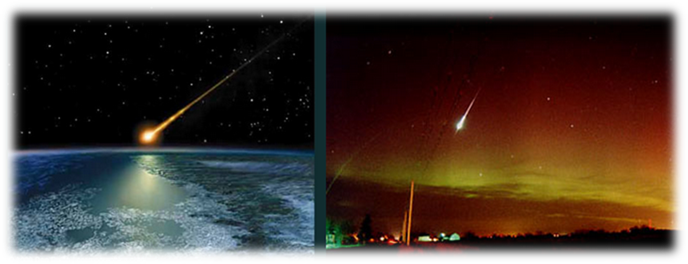
Meteorites
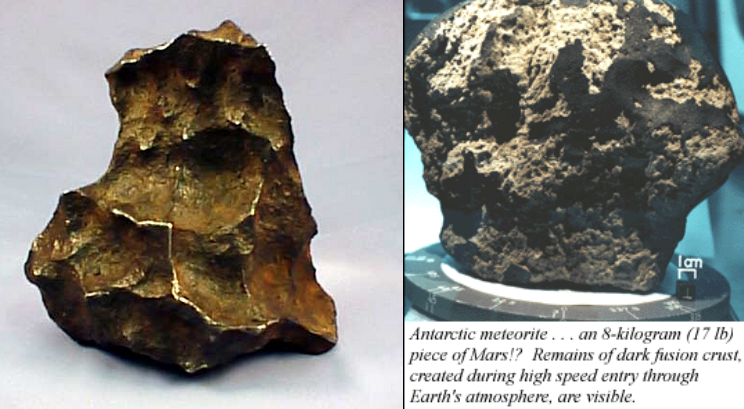
Meteorites have hit the
Earth’s surface and scientists have recorded the damages done by their impact.
In 1908, a meteorite hit a region of
Meteor Crater in
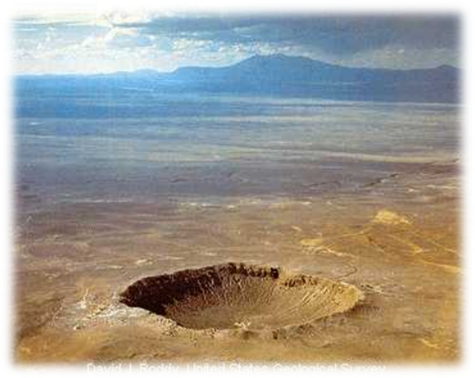
Meteor Crater,
Meteors are composed of a variety of metal
and rock-metal combinations. The chart below shows the main meteorite types.
|
Meteorite Types |
|
Iron primarily iron
and nickel; similar to type M asteroids |
|
Stony Iron mixtures of iron
and stony material like type S asteroids |
|
Chondrite by far the
largest number of meteorites fall into this class; similar in composition to
the mantles and crusts of the terrestrial planets |
|
very similar in
composition to the Sun, but lesser amounts volatiles; similar to type C
asteroids |
|
Achondrite similar to
terrestrial basalts; the meteorites believed to have originated on the Moon
and Mars are achondrites |
Other planets and moons have
been impacted by meteors. One look at our moon and you can see that the
evidence is clear. The Earth’s moon must have had a very violent past as seen
by looking at all the impact craters on its surface. Other planets’ moons have
also had close encounters with meteors.
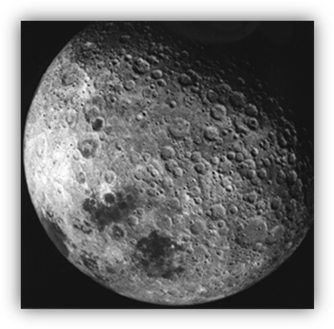
Near Side of Our Moon
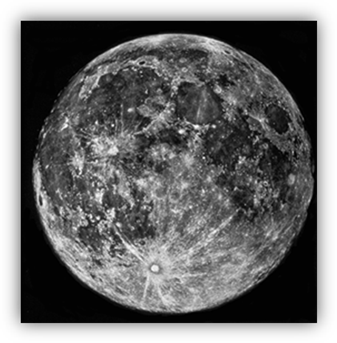
Far Side of Our Moon
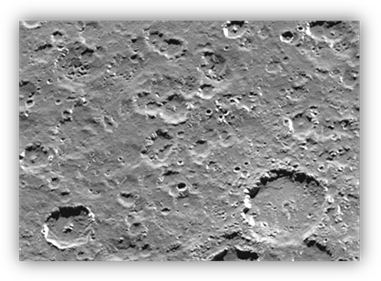
Surface of Calisto – Moon of Jupiter
Looking at the pictures
above, you can see that a thick atmosphere can protect a planet or moon. Both
of the moons above have thin or no atmospheres, so the meteors do not burn up
before they get to the surface. For this reason, they have hundreds of impact
craters on their surfaces. There is also evidence of collisions between
asteroids and planets. Look at the pictures below.
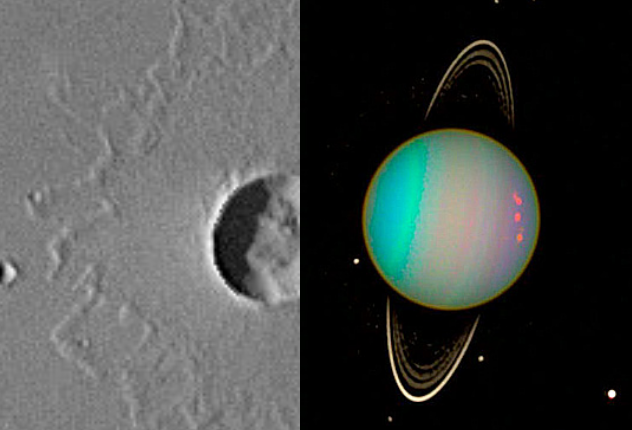
(above) The picture on the left is an
impact crater on the face of Mars. The picture on the right is the planet
Uranus. The planet is tipped on its side and scientists believe that it may
have collided with a planet-sized asteroid early in our solar systems history.
What exactly happens when a meteor hits
the surface of a planet? Obviously the size, density, and force at which the
meteor hits the surface determine the size and depth of the crater that forms.
The first thing that happens is a fracturing of the surface rock and that rock
is forced out of its original position as the meteor pushes into the planet.
The force of the impact sprays the surface rock out of the impact area. This
debris is called ejecta. Some of the planet’s rock will melt due
to the high temperature of the meteor and some of the meteor’s pieces will melt
or vaporize upon impact. Depending on the force and angle of impact, different
types of crater formations will occur. Look at the following chart that
describes crater formations:
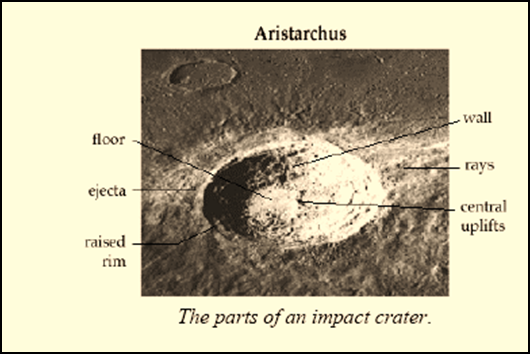
|
Floor - bottom of a crater, either bowl-shaped or flat,
usually below the level of the surrounding ground. |
|
|
|
Walls
-
interior sides of a crater, usually steep. They may have giant stair-like
terraces that are created by slumping of the walls due to gravity. |
|
Rim - edge
of the crater. It is elevated above the surrounding terrain because it is
composed of material pushed up at the edge during excavation. |
|
Ejecta -
rock material thrown out of the crater area during an impact event. It is
distributed outward from the crater's rim onto the planet's surface as
debris. It can be loose materials or a blanket of debris surrounding the
crater, thinning at the outermost regions. |
|
Rays - bright streaks extending away from the crater
sometimes for great distances, composed of ejecta material. |
The following
activity may require teacher assistance.
|
Activity:
Making Impact Craters |
|
PURPOSE: To observe and
record basic concepts about impact craters. |
|
OBJECTIVES:
Draw
and describe the shapes made by the various objects dropped. Observe that a
crater’s size and feature’s depend on the mass and velocity of the impactor. |
|
MATERIALS: o
Pictures of craters from the Moon and Mars (Printed
from internet is best.) o
Safety glasses o
Large tub or aluminum pan o
Fine white powder (sand, flour, sugar, etc.) o
Fine colored powder (cocoa, powdered drink mix, dry
powdered tempera paint, pudding, etc.) o
Sieve, sifter, large spoon, or cheese cloth to
sprinkle the dark powder o
Two same sized balls of different weights (e.g.,
marbles, ball bearings, gum balls, grapes, etc.) o
Two same weight balls of different sizes (e.g.,
rubber balls, golf balls, water-filled ping pong balls). Try to have one
small and one large ball. o
Small irregularly shaped rocks. o
Tape measure o
Toothpicks o
3x5 index card (to smooth the surface of the powder) o
Newspaper or drop cloths o
Paper and pencils for sketches of craters o
Paper to design a data chart |
|
DIRECTIONS: Look at your pictures of the Moon and
Mars. Find the parts of a crater and label them on the picture. From what you
have learned in this unit, what factor’s influence a crater’s appearance? |
|
1.Complete
the following steps: ·
Fill a pan with white powder (sand, flour, etc.) to
a depth of about 2.5 centimeters (1 inch). ·
Tap the pan on the table to settle the material and
smooth the surface. ·
Sprinkle a fine layer of colored powder (see
materials list) evenly and completely over the white layer. ·
Sprinkle another layer of white powder over the top
of the colored layer. 2.
Use safety glasses to protect eyes from flying powder. 3.
Design your own data chart/sheet with 12 boxes so that you can fill in
measurements for the drops. 4.
Drop the different mass (weight) balls from three different heights. (Balls
are similar in size.) Draw the crater and then measure the diameter of each
crater and the distance the ejecta traveled after each impact. Use the
toothpick to help you measure the depth of the crater. Record your results. 5.
Drop the different sized balls from three different heights. (Balls are
similar in weight.) Draw the crater and then measure the diameter of each
crater and the distance the ejecta traveled after each impact. Use the
toothpick to help you measure the depth of the crater. Record your results. 6. Answer the
following questions: a. How did crater
size change when balls of different mass (i.e., weight) were dropped from the
same height? b. How would you
state the general relationship between a ball's mass and the crater size? c. How did the size
of the balls affect the crater sizes? d. How would you
state the general relationship between a ball's size and the crater size? e. How did the
different speeds of the balls affect the crater sizes? f. How would you
state the general relationship between a ball's speed and the crater size? |
|
Re-examine your
pictures of the moon and Mars. Choose two craters on each picture that have
different formations and write a hypothesis on how they formed. Use your data
from the experiment to support your hypothesis. |
Now that we have
finished an in depth look at asteroids, let’s investigate some other space
debris in our solar system – the comets.
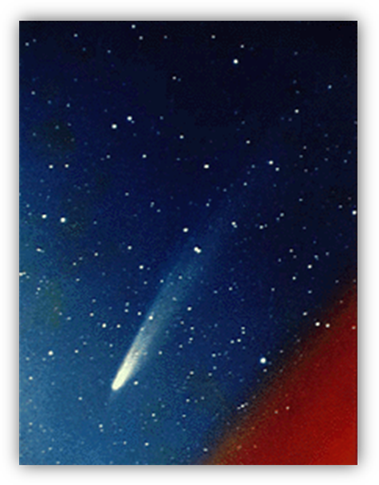
Comets
Comets are lumps of ice
and rock that travel the expanse of our solar system. Like the planets and
asteroids, they travel in predictable orbits. Scientists have observed comets
for centuries and have recorded data on their comings and goings. Some
mathematical theories state that comets come from outside our solar system from
a large area forming a cloud around our system. The area is called the Oort Cloud. This theory was not
developed until around 1950. In ancient times, the appearance of a comet could
be interpreted as something magical and considered lucky or unlucky. This is
understandable since some of the orbits take hundreds or thousands of years to
come back to Earth’s vision. There are recordings of Chinese sightings of the
Halley Comet as long ago as 240 BC.
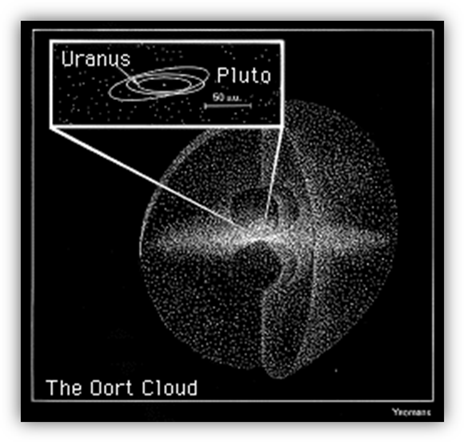
Some comets are believed to be coming from
closer in than the Oort Cloud, from a place within
our solar system. Scientists call this area the Kuiper Belt,
located past the orbit of Pluto.
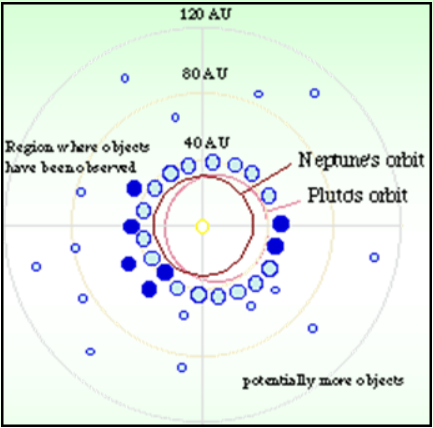
It is believed that as the
comets travel in the Oort Cloud or the Kuiper Belt,
they are loosely bound by the Sun’s gravitational pull. But when they travel
closer to a planetary orbit, they can be drawn off course and enter a new orbit
traveling toward the sun and passing through our solar system.
Let’s take a closer look at
the composition of a comet. As stated earlier, comets are made up of ice (both
water and frozen gases) and particles of dust that did not go into the
formation of the planets. As they travel near the sun, they begin to evaporate
and scientists have given names to the distinct parts of the comet.
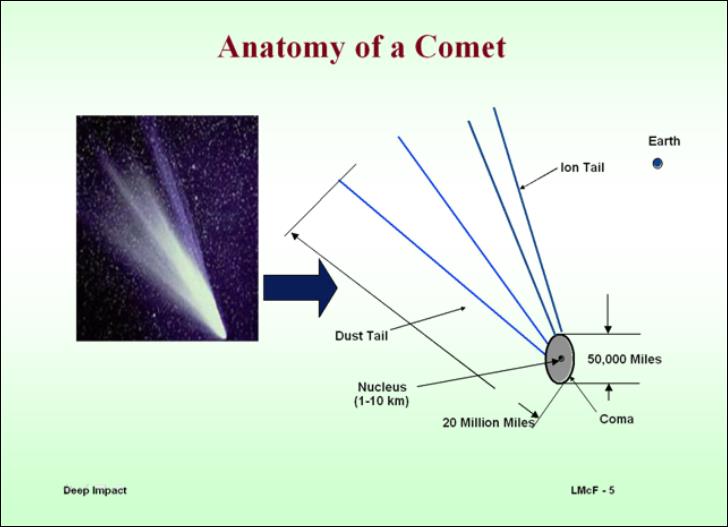
·
nucleus: relatively solid and stable, mostly ice and gas with a small amount of
dust and other solids;
·
coma: dense cloud of water, carbon dioxide and other neutral gases sublimed
from the nucleus;
·
hydrogen cloud: huge (millions of km in diameter) but very sparse envelope of neutral
hydrogen;
·
dust tail: up to 10 million km long composed of smoke-sized dust particles driven
off the nucleus by escaping gases; this is the most prominent part of a comet
to the unaided eye;
· ion tail: as much as several hundred million km long composed of plasma and laced with rays and streamers caused by interactions with the solar wind.
One of the most famous of
comets is Halley’s Comet. Sir Edmond Halley was the first to predict the return
of Halley’s Comet, using
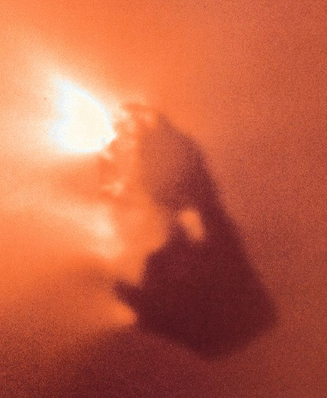
The picture above is the
nucleus of Halley’s Comet as taken by the spacecraft Giotto, which visited the
comet as it passed in 1986. Scientists learn a great deal about the make up of
comets from these space crafts, but even more information can be learned about
the formation of our solar system since the comets contain matter that is left
over from that formation.
Other famous comets have been
studied in recent years. The Hyakutake and Hale-Bopp comets were observed in
1996 and 1997. Hale-Bopp was one of the brightest comets ever seen from Earth.
The Shoemaker-Levy comet was seen from Earth in 1994 and as it traveled near
Jupiter, was caught in Jupiter’s gravitational pull and crashed into the planet.
Scientists have space crafts studying many comets, but an exciting comet
mission will actually include a spacecraft landing on the comet Churyumov-Gerasimenko !
Unit Summary
Much has been
learned about our planet and about our solar system by studying asteroids and
comets. Galileo and
Not all of the
information gained from asteroids and comets is used to study the history of
our solar system. Our Earth has been hit in the past by asteroids and comets
with very devastating results. Many scientists are watching the sky for
potential danger from impact of asteroids in the future and they are
formulating theories, calculating dangers, and eventually building technologies
that will help protect our Earth from impacts that would harm our lives.
